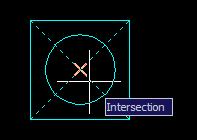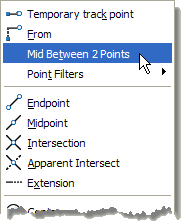AutoCAD Tips & Tricks
Today's Tip
Object Snap Cycling
 When drawings get crowded with lots of detail, it can be difficult to select the required snap point with running object snaps. Invariably, the snap point AutoCAD finds is not the one you want. This is where object snap cycling comes to the rescue. With running object snap turned on, hover the cursor close to the snap point you want and hit the Tab key on the keyboard to move between the various possible snap points near the cursor. Keep hitting the Tab key until you find the snap point you want. When you've got it, left-click to select the point.
When drawings get crowded with lots of detail, it can be difficult to select the required snap point with running object snaps. Invariably, the snap point AutoCAD finds is not the one you want. This is where object snap cycling comes to the rescue. With running object snap turned on, hover the cursor close to the snap point you want and hit the Tab key on the keyboard to move between the various possible snap points near the cursor. Keep hitting the Tab key until you find the snap point you want. When you've got it, left-click to select the point.
Yesterday's Tip
AutoCAD Expert
Are you an expert in AutoCAD? Well according to Autodesk you aren't, well not unless you tell the program otherwise. The EXPERT system variable (default 0) can be changed so that annoying "Are you sure?" commands will go away. Here is the list and what they do:
- EXPERT = 0
- Issues all prompts normally.
- EXPERT = 1
- Suppresses "About to regen, proceed?" and "Really want to turn the current layer off?"
- EXPERT = 2
- Suppresses the preceding prompts and "Block already defined. Redefine it?" (BLOCK) and "A drawing with this name already exists. Overwrite it?" (SAVE or WBLOCK).
- EXPERT = 3
- Suppresses the preceding prompts and those issued by the LINETYPE command if you try to load a linetype that's already loaded or create a new linetype in a file that already defines that linetype.
- EXPERT = 4
- Suppresses the preceding prompts and those issued by UCS Save and VPORTS Save if the name you supply already exists.
- EXPERT = 5
- Suppresses the prompt, "That name is already in Use, redefine it?" issued by the -DIMSTYLE Save option when you supply the name of an existing dimension style.
Monday's Tip
Using Imprint to sub-divide faces
 The Imprint command () gives the first impression of nothing more than adding graffiti to solids. Upon closer investigation, however, we find that it actually modifies the face on which it is placed, effectively sub-dividing it. Sub-divided faces can then be extruded using the Extrude faces command ().
The Imprint command () gives the first impression of nothing more than adding graffiti to solids. Upon closer investigation, however, we find that it actually modifies the face on which it is placed, effectively sub-dividing it. Sub-divided faces can then be extruded using the Extrude faces command ().
Procedure
- Create a box.
- Draw a line on one of the faces.
- Imprint that line on the solid.
- Use Extrude faces to extrude the sub-divided face.
To generate this modified part with Boolean operations would not be difficult but, as we all know, speed and accuracy are the name of the game. The procedure describe above can be auto-executed with the command macro:
^C^C_line;\\;_solidedit;b;i;\last;y;;;f;E;\;\\;;
The UI could benefit from some advanced programming, but if one pays attention to the Command Prompts, it's not so bad.
Note: This tip relates to versions of AutoCAD before 2007. Although the technique works with 2007 and above, the same operation can be achieved more easily using the Presspull tool.
Sunday's Tip
Take control of QNEW
Have you ever wanted to change your QNEW command or your "New" button to open a certain .dwt file? Here's how:
Go to the options menu and select the tab.
Go down to .
Select .
Select the .dwt file you want to use.
Now when you open AutoCAD or hit the "New" button this .dwt will load every time.
Saturday's Tip
Shift + Right-click menu
 Object snaps are really inportant in AutoCAD and in addition to the running object snaps, many AutoCAD users have the Object Snap toolbar permanently docked on their screen. However, as screen space is often at a premium, you might like to consider accessing the object snaps from the Shift + Right-click menu. If you didn't know about this, you'll find that it's even better than the Object Snap toolbar because it takes up no space and it contains all the object snaps including "Mid Between 2 Points" and the Point Filters.
Object snaps are really inportant in AutoCAD and in addition to the running object snaps, many AutoCAD users have the Object Snap toolbar permanently docked on their screen. However, as screen space is often at a premium, you might like to consider accessing the object snaps from the Shift + Right-click menu. If you didn't know about this, you'll find that it's even better than the Object Snap toolbar because it takes up no space and it contains all the object snaps including "Mid Between 2 Points" and the Point Filters.
Friday's Tip
Mid Between 2 Points (m2p)
 Sometimes you might want to find a point midway between two other points. In the past, you might have drawn a line between these two points and then used "Snap to Midpoint" but this requires the drawing of a construction line and isn't very efficient.
Sometimes you might want to find a point midway between two other points. In the past, you might have drawn a line between these two points and then used "Snap to Midpoint" but this requires the drawing of a construction line and isn't very efficient.
Enter the m2p object snap. This will find the midpoint between any two picked points without the need for a construction line.
How it works: Say you want to draw a circle midway between two squares, start the circle command and then enter "m2p" when prompted to specify the center point. Now just follow the prompts.
Command: circle
Specify center point for circle or [3P/2P/Ttr (tan tan
radius)]: m2p
First point of mid: (pick first point)
Second point of mid: (pick second point)
Specify radius of circle or [Diameter] <20.000>: (pick to complete circle)
Thursday's Tip
Add additional "standard scales"

To create additional "standard scales" in AutoCAD, type SCALELISTEDIT. You will then see the Edit Scale List dialog, shown on the right.
Click on the Add… button. In the Add scale dialog, enter the name of the scale, for example "1:1250", this is the name that will appear in the list. Then enter the Paper units and Drawing units as desired.
Note: "Drawing units" refers to the modelspace units.
Tutorials of the Moment
The most recently viewed tutorials
Modifying Objects
|
Creating a Walkthrough
|
|
Last visited: less than one minute ago |
Last visited: less than one minute ago |
|
Animation
|
AutoCAD 2010: Starting a Command
|
|
Last visited: less than one minute ago |
Last visited: 2 minutes ago |
Local Navigation
Tutorials
Helping you to learn more of the skills you need, for free.
Featured Tutorial:
CADTutor tutorials are comprehensive lessons, designed to give you a deeper understanding.
Total tutorials: 108
Sponsored Links





